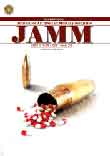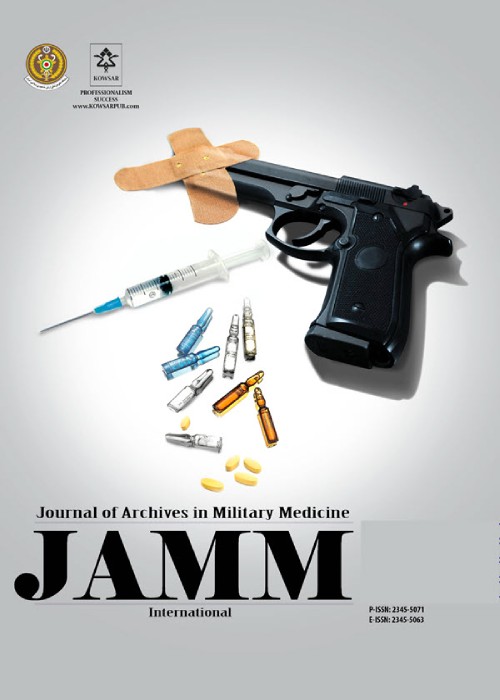فهرست مطالب

Journal of Archives in Military Medicine
Volume:4 Issue: 2, May 2016
- تاریخ انتشار: 1395/04/26
- تعداد عناوین: 6
-
Page 2BackgroundHydroxyapatite (HA) has been widely used in hard-tissue repair applications, such as implant coatings and bone substitutes, because of its stability under in vivo conditions and its osteoconductivity.ObjectivesThe aim of this study was to investigate the effects of HA coating applied on two different metallic materials that are used as implants, with regard to the substrate and electrochemical parameters of their microstructure.Materials And MethodsHA coating was applied on AZ31 magnesium alloy and stainless steel 304, metallic materials used as implants, and the effects of the substrate and electrochemical parameters on their microstructure were investigated.ResultsIt was observed that at 2 V potential and 85°C for AZ31 and steel 304, the coatings did not have proper coverage and the grains were coarse. By hindering the grain growth, complete coverage with a uniform and fine structure will be achieved. There was a difference in morphology that was probably due to the different open circuit potentials of these two alloys. Magnesium alloys have more negative potential, in which H2 formation can hinder growth of HA flakes, but in Ti base alloys, the formation of H2 gas does not easily form in the working potential, so the HA coating can grow easily.ConclusionsNanosized HA coating can be obtained on stainless steel 304, AZ31 magnesium alloy, and Ti-6Al-4V by cathodic deposition using pulse and direct cathodic electrodeposition from a proper electrolyte solution, regardless of the substrate material.Keywords: Microstructure, Hydroxyapatite, Coating
-
Page 3BackgroundThe North Atlantic treaty organization (NATO)-led international security and assistance force (ISAF) conducted training, development, and humanitarian activities in addition to security operations during its 13 years in Afghanistan.ObjectivesThe aim of this study was to present the emergency department experiences of Kabul Ataturk Role II military hospital.Materials And MethodsWe performed a retrospective observational study of emergency department admissions at Kabul Ataturk Role II Military hospital during a 12-month period from August 2012 through July 2013.ResultsDuring the 12-month study period, 4348 patients were admitted to our emergency department. Admissions were evaluated as two groups according to trauma exposure of the patients and we detected that the Afghan civilian group had a higher number of admissions with stab wounds and burn injuries compared to the other groups. Moreover, our study results presents higher rates of surgical, orthopedic, and mixed treatments on the Afghan civilian group compared with other groups of patients.ConclusionsHumanitarian care facilities, including medical assistance, are still vital for the Afghan society. Participation of women and/or Muslim caregivers may enhance accessibility, particularly for Afghan women. We believe that the availability of emergency medicine facilities in a hospital setting at a reachable location for Afghan civilians is an effective and profitable choice for medical services. In terms of emergency medicine, the department should be prepared for orthopedic traumas, combat injuries including mine and gunshot wounds, and burn injuries.Keywords: Afghanistan, Delivery of Health Care, Humanitarian Care, Burn, Emergency Department
-
Page 4BackgroundOral health is a major element of general health. Dental caries, periodontal diseases and oropharyngeal cancers are among the major health challenges in developed and developing countries.ObjectivesThis study aimed to evaluate the oral health indices, including the decayed, missing and filled teeth (DMFT) and periodontal indices, oral diseases and other related variables in Iranian military forces.Materials And MethodsIn this cross-sectional study, 420 active-duty male individuals were selected from the Iranian ground force (GF), Air Force (AF), Navy, marine and submarine (NY) and the commander general headquarters (CG). A WHO-approved and regionally validated questionnaire was used and clinical observation was performed based on a standard protocol.ResultsThe mean age of the participants was 34.76 (± 8.16) years. The mean DMFT for the total groups was 9.67 (± 5.34) and 3.3% of them were caries-free, while 21.9% of the cases had root caries. The mean number of existing teeth was 25.4 (± 3.26). Among 11760 teeth that were examined, 9.73% had caries. The mean healthy sextant was 2.58% per person, while 45.5% of sextants had calculus. A community periodontal index was equal to 3 in 49.6% of the individuals. No history of oral health education was reported in 66% of the study group and the frequency of systematic disease comorbidities was 24.7%. Navy, in particular, had a greater oral health problems compared to other forces. For instance, 91.7% of all participants from Navy had calculus at least in one sextant. Periodontal pockets were also reported in more than 40.4% of the Navy forces. Interestingly, there was a significant and direct association between cardiovascular diseases and DMFT (P = 0.014) after adjustment for age.ConclusionsAlthough, oral health profile for Iranian military units was better than the civilian population, Improvements in prevention services, oral health education and periodontal treatments are essential in the Iranian armed forces, particularly in Navy and Air-Force.Keywords: Oral Health, Army Force, Dental Caries, Periodontal Diseases, Calculus, Health Education
-
Page 6Central arterial stiffness (CAS) is an independent predictor of cardiovascular mortality. If in one side, exercise training can reduce CAS and protect health; on the other side, CAS might be increased in individuals with very strenuous training routines. This chronic increase in CAS is observed acutely, right after a strenuous exercise session. Both chronic and acute increases in CAS are associated with cardiovascular risk factors such as left ventricle hypertrophy, reduction in baroreceptor sensitivity, increased aneurism formation and stroke incidence; besides, they contribute to hypertension, myocardial infarction, congestive heart failure, dementia and atherosclerosis. However, there are many reasons to believe that trained individuals are protected by other training adaptations and that increased CAS would not be too dangerous in these cases. Nevertheless, even when CAS is increased through exercise training, other harmful adaptations (e g, left ventricle hypertrophy) are aroused together. After debating these questions along the text, it was concluded that individuals should make a complete clinical check-up when decided to face strenuous training routines. A new debate is suggested: personalized exercise programs might be prescribed according to individual cardiovascular risks including CAS and the guidelines for exercise prescriptions proposed by health organizations need to attend these special cases.Keywords: Exercise, Vascular Stiffness, Cardiovascular Physiology


